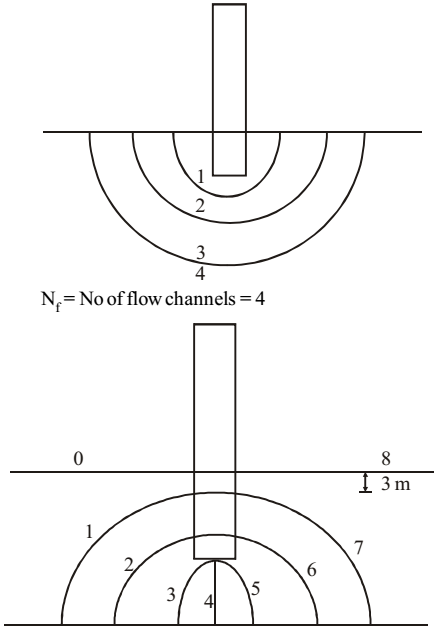Soil mechanics miscellaneous
Direction: A sand layer found at sea floor under 20 m water depth is characterised with relative density = 40%, maximum void ratio = 1.0, minimum void ratio = 0.5, and specific gravity of soil solids = 2.67. Assume the specific gravity of sea water to be 1.03 and the unit weight of fresh water to be 9.81 kN/m3
- What would be the effective stress (rounded off to the nearest integer value of kPa) at 30 m depth into the sand layer?
-
View Hint View Answer Discuss in Forum
Relate density, ID = .40 (40%)
emax = 1, emin = 0.5ID = emax - e emax - emin 4 = 1 - e 1 - 5
∴ e = 0.8
Effective stress = γsub.hγsub = (G - 1) .γ'w (1 + e)
γ'w = unit weight of sea water.
∴ γ'w = G × γw = 1.03 × 9.81 = 10.1 kw/m3.∴ γsub = (G - 1)γ'w (1 + e) = (2.67 - 1) × 10.1 = 9.37 mN/m3. (1 + .8)
Effective stress = 9.37 × 30 = 281.1 kN/m2 = 281. 1 kPaCorrect Option: D
Relate density, ID = .40 (40%)
emax = 1, emin = 0.5ID = emax - e emax - emin 4 = 1 - e 1 - 5
∴ e = 0.8
Effective stress = γsub.hγsub = (G - 1) .γ'w (1 + e)
γ'w = unit weight of sea water.
∴ γ'w = G × γw = 1.03 × 9.81 = 10.1 kw/m3.∴ γsub = (G - 1)γ'w (1 + e) = (2.67 - 1) × 10.1 = 9.37 mN/m3. (1 + .8)
Effective stress = 9.37 × 30 = 281.1 kN/m2 = 281. 1 kPa
Direction: The flow net around a sheet pile wall is shown in the sketch. The properties of the soil are: permeability coefficient = 0.09 m/day (isotropic), specific gravity = 2.70 and void ratio = 0.85. The sheet pile wall and the bottom of the soil are impermeable.
- The factor of safety against the occurrence of piping failure is
-
View Hint View Answer Discuss in Forum
F = ic ie ic = (G - 1) = 2.7 - 1 = 0.919 (1 + e) 1 + 8.5 ie = Dh l ∆h = ∆H Nd
(head loss between consecutive equipotential lines)= 8.5 = 1.063 8
L = 3 m (given in figure)ie = 1.063 = 0.354 3 ∴ F = 0.919 = 2.59 0.354 Correct Option: C
F = ic ie ic = (G - 1) = 2.7 - 1 = 0.919 (1 + e) 1 + 8.5 ie = Dh l ∆h = ∆H Nd
(head loss between consecutive equipotential lines)= 8.5 = 1.063 8
L = 3 m (given in figure)ie = 1.063 = 0.354 3 ∴ F = 0.919 = 2.59 0.354
- The seepage loss (in m³ per day per unit length of the wall) of water is
-
View Hint View Answer Discuss in Forum

Nd – no of equip potential drops = 8 (Remember to count from zero)
Seepage loss,∆q = k ∆H Nf Nd
∆H = difference between upstream and downstream water level
= 10 – 1.5 = 8.5 m
∴ ∆q = 0.09 × 8.5 × (4/8) = 0.3825 m3/ day/ m2Correct Option: B

Nd – no of equip potential drops = 8 (Remember to count from zero)
Seepage loss,∆q = k ∆H Nf Nd
∆H = difference between upstream and downstream water level
= 10 – 1.5 = 8.5 m
∴ ∆q = 0.09 × 8.5 × (4/8) = 0.3825 m3/ day/ m2
Direction: Water is following through the permeability apparatus as shown in the figure. The coefficient of permeability of the soil is k m/s and the porosity of the soil sample is 0.50.
- The total head, elevation head and pressure head in metres of water at the point R shown in the figure
-
View Hint View Answer Discuss in Forum
Here overflow level of water is taken as datum
Total head loss, ∆h = 0.4 + 0.8 = 1.2 m
Depth of sample, l = 1.2 m.
hydraulic gradient,i = ∆h l = 1.2 = 1 1.2
Total head at R = 1.2 – 0.8 × 1 = 0.4 m
Here datum head = 0 (datum is at R) (elevation head)
Total head = pressure head + datum head
0.4 = pressure head + 0
∴ pressure head = 0.4 mCorrect Option: C
Here overflow level of water is taken as datum
Total head loss, ∆h = 0.4 + 0.8 = 1.2 m
Depth of sample, l = 1.2 m.
hydraulic gradient,i = ∆h l = 1.2 = 1 1.2
Total head at R = 1.2 – 0.8 × 1 = 0.4 m
Here datum head = 0 (datum is at R) (elevation head)
Total head = pressure head + datum head
0.4 = pressure head + 0
∴ pressure head = 0.4 m
Direction: Laboratory sieve analysis was carried out on a soil sample using a complete set of standard IS sieves. Out of 500g of soil used in the test, 200g was retained on IS 600μ sieve, 250g was retained on IS 500μ sieve and the remaining 50g was retained on IS 425μ sieve.
- The classification of the soil is
-
View Hint View Answer Discuss in Forum
600 μ = 600 × 10–6 m = .6 × 10–3 m = .6 mm
Similarly 500 μ = 0.5 m
Maximum amount of soil is of size between 0.5 and 0.6
So it is sand.
∵ Cu > 6, it is graded.
∴ it is SCorrect Option: B
600 μ = 600 × 10–6 m = .6 × 10–3 m = .6 mm
Similarly 500 μ = 0.5 m
Maximum amount of soil is of size between 0.5 and 0.6
So it is sand.
∵ Cu > 6, it is graded.
∴ it is S

